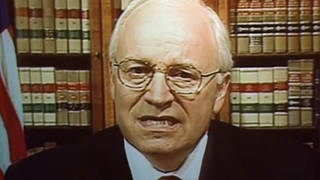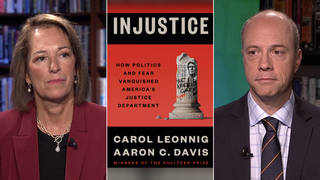
The movie Oppenheimer about J. Robert Oppenheimer — the “father of the atomic bomb” — focuses on Oppenheimer’s conflicted feelings about the weapons of mass destruction he helped unleash on the world, and how officials ignored those concerns after World War II as the Cold War started an arms race. Journalist Greg Mitchell says that while the film is well made and worth seeing, “the omissions are quite serious.” He says there is little mention of the dangers of radiation and no focus on the impact of the bomb on its victims in Hiroshima and Nagasaki. The film also does not question the necessity of using the bomb in the first place, upholding the “official narrative … that has held sway since 1945,” says Mitchell. Mitchell is a documentary filmmaker and the author of numerous books, including The Beginning or the End: How Hollywood — and America — Learned to Stop Worrying and Love the Bomb. He was editor of Nuclear Times magazine from 1982 to 1986 and has written about this new film for Mother Jones and on his Substack, and in an opinion piece for the Los Angeles Times headlined “'Oppenheimer' is here. Is Hollywood still afraid of the truth about the atomic bomb?”
Transcript
AMY GOODMAN: This is Democracy Now!, democracynow.org, The War and Peace Report. I’m Amy Goodman.
We end today’s show at the movies. Amidst the ongoing SAG-AFTRA strike, Universal Pictures canceled the red carpet for the U.S. premiere of Christopher Nolan’s Oppenheimer. Meanwhile, people filled theaters this weekend to see the film about J. Robert Oppenheimer, known as the “father of the atomic bomb.” This is the trailer.
J. ROBERT OPPENHEIMER: [played by Cillian Murphy] We imagine a future, and our imaginings horrify us. They won’t fear it until they understand it. And they won’t understand it until they’ve used it. Theory will take you only so far. I don’t know if we can be trusted with such a weapon. But we have no choice.
AMY GOODMAN: The physicist J. Robert Oppenheimer developed and tested the world’s first atomic bomb in New Mexico. In that state, the film is being preceded by a 15-second advertisement produced by the Union of Concerned Scientists that notes, quote, “Oppenheimer’s bomb led to decades of nuclear testing across the Southwest. Communities still suffer health impacts related to the tests, many without government recognition or justice.”
For more, we’re joined by Greg Mitchell, documentary filmmaker, author of numerous books about this very topic, including The Beginning or the End: How Hollywood — and America — Learned to Stop Worrying and Love the Bomb. He was editor of Nuclear Times magazine in the 1980s. He’s written about this new film for Mother Jones, on his Substack and in an opinion piece for the L.A. Times headlined “'Oppenheimer' is here. Is Hollywood still afraid of the truth about the atomic bomb?”
Greg, welcome back to Democracy Now! Some are calling this —
GREG MITCHELL: Thank you.
AMY GOODMAN: — the greatest anti-nuclear film ever. You have a different and a critical perspective on the film. Why don’t you just talk about your response to the film, what it got right, what it got wrong?
GREG MITCHELL: Right, yes. I saw an early screening of the film, before a lot of the critical opinions came in, so I saw it with a very open mind. And I think people should see the film. I think it’s very well written, well acted, well directed. And I think it probably has good intentions. So, I would certainly encourage people to see it.
However, I did find a number of issues with it, which I’ve written about, really, every day on my blog and newsletter. And it’s not so much what’s shown in the movie. The movie does end up and wants to warn people about future dangers and future threats of the bomb, which is — you know, which is admirable. And I’m not sure any director besides Christopher Nolan, with a long track record of popularity, would have or could have had this film made. However, the omissions are quite serious.
You’ve already mentioned one, which is really the lack — almost the total lack of any mentions or exploration of the radiation, revolutionary new radiation effects of this weapon, both in the Trinity test, which is one of the main focuses of the film, showing the Trinity test — it does not show the radioactive cloud that drifted away and the fallout that affected people, and then, of course, as you mentioned, the decades of nuclear tests, exposure to soldiers and workers and so forth. So, that’s one thing.
Another thing is that it does not show any images of people on the ground in Hiroshima and Nagasaki. There’s nothing. We see Oppenheimer watching a screen, where it sounds like the footage is being aired or screened. We do not see any of those images. We just see him growing a little bit disturbed about it. In the same time, they do not mention that 85% of the victims in Hiroshima and Nagasaki were civilians. They don’t mention that at all. And another thing, they barely mention Nagasaki. It’s kind of thrown in in passing in the last part of the film. It’s just kind of tossed in as if it was kind of forced into the script.
And for my mind, one of the most important things is, certainly, it does not challenge in any way the Hiroshima narrative or official narrative, as I call it, that has held sway since 1945 about the decision to use the bomb — you know, we can talk about that more; it’s very important — and the legacy for today. Instead, I think when people say it’s an anti-nuclear film, you know, there is the message of dangers for today and control of the weapons and so forth, but it does not challenge the use of the bomb in 1945. I think you’re supposed to take away from the haunted visage of Oppenheimer and the great actor Cillian Murphy, his sort vague, conflicted, confusing regrets that he seemed to issue during the movie and during his life, but, in fact, as I’ve shown at my blog and in my books, Oppenheimer in fact defended the use of the bomb against Japan 'til the end of his life, right up to 1965 as 1966. So the film is a little misleading in that. But, in fact, it's true and it’s quite accurate that Oppenheimer really did not reject it, and the film certainly does not challenge the decision to use the bomb. It’s more moving forward from 1945.
AMY GOODMAN: So, when you talk about Hiroshima and Nagasaki, in fact, the footage that came out, that these scientists were shown at Los Alamos afterwards, the horror of the skin melted, there’s one reference to it, you know, an image of it.
GREG MITCHELL: An image, yeah.
AMY GOODMAN: But the actual film was classified for years. Is that right, Greg?
GREG MITCHELL: Yeah. Well, yeah, I’ve written a whole book called Atomic Cover-up about it, and I directed a film two years ago that got quite a bit of attention, including on this show, called Atomic Cover-up, which looked at the post-Hiroshima/Nagasaki complete suppression of both Japanese footage and the U.S. color footage that was seized and suppressed for many decades. So, of course, we don’t see that in the film — I wouldn’t necessarily expect that.
But, you know, the decision to use the bomb, in the film, is handled — I mean, there is an accurate scene which shows, at the end of May of 1945, the Interim Committee, which was Truman’s leading advisory committee on this, had a meeting where the subject sort of briefly came up, how to use the bomb, and should they use it. Oppenheimer, as he did in real life, shot this down and said this was — you know, couldn’t work or wouldn’t work, it was the wrong idea to do a demonstration shot, you know, the bomb had to be used. And then one of the other members of the committee then gives a ringing explanation, which became the Hiroshima narrative that still carries the day today, you might say, with the media and some historians, which is that only the use of the bomb, only the use of two bombs, really, would prevent a bloody invasion of Japan, hundreds of thousands of U.S. casualties and so forth. And this is not really challenged in the film, and not by Oppenheimer and not really in the film narrative. It then goes to the future, and Hiroshima and Nagasaki are kind of left alone.
And, you know, the danger of this and the legacy and the reason I’ve written so much on this for the past 40 years, really, is that the lessons for today is that, yes, everyone says we should never use nuclear weapons again, it’s terrible, they must not be used. But on the other hand, we make these two exceptions, from 1945, of Hiroshima and Nagasaki.
AMY GOODMAN: For people —
GREG MITCHELL: And we have a — and we have a — yeah, go on.
AMY GOODMAN: For people to understand, Greg, I mean, these scientists that came together at Los Alamos, this secret community that was built for them to build the atomic bomb, were motivated by taking on Nazi Germany. But then Nazi Germany surrenders, right?
GREG MITCHELL: Correct.
AMY GOODMAN: Or is beaten, is defeated. So, if you can explain further, because this is something you’re so steeped in, what it meant then to decide to use this bomb on Japan, and also where the Soviet Union came into this, where Russia came into this?
GREG MITCHELL: Right. Right, yeah. Of course, the motivation for making the bomb was largely Hitler and Nazi Germany. Of course, many of the top physicists were refugee Jewish scientists, physicists from Germany. And it’s really the main reason we beat Hitler to the bomb. Germany surrendered, and we were still fighting Japan, of course, very, very bloody battles and bombing their cities that spring into the summer. So, of course, then the target became Japan, and the focus.
And there were scientists, such as Leo Szilard, who did circulate a petition that asked people to — asked other scientists to sign this petition, that would go to Truman, that would ask them to not use the bomb, or at least delay using the bomb. Oppenheimer is one of those people who squelched that petition, incidentally. But, basically, the decision was made that we, even though an invasion of Japan was not scheduled ’til November and December, that we had to use this bomb, or we wanted to use this bomb, as soon as possible. And so, we had the Trinity test, and then we had the dropping of the bomb in early August.
You mentioned the Soviet aspect of it. And it’s very important, because we — at our urging, insistence, Stalin agreed to enter the war by mid-August, and yet we went head and dropped the bomb before the Soviets entered the war. Some people say that the Soviet entry, along with a couple other negotiating things, could have ended the war pretty much in the same timeframe prime that it ended. Truman himself, as I’m sure you’re aware, wrote in his diary, “Fini Japs” when the Soviets would enter the war. General Eisenhower later said it was totally unnecessary to use the bomb, that Japan was going to surrender very soon.
And, you know, you have to step back a bit, which the film doesn’t do the best job of, of showing, OK, you deliberately targeted and exploded these bombs over the center of two cities. That was the aim. Oppenheimer was in on that. Everyone knew in the targeting committee that the aim was to really kill as many people and cause as much destruction as possible — which they executed. This was not a surprise. So, you really have to go back and say, was it worth — especially to the people, of course, who died, and the lessons for today, where we still have a first-strike policy today, that we can use nuclear weapons in response to a crisis or conventional attack. And the lesson that we have from Hiroshima and Nagasaki, which is still endorsed by the media every year and many historians, is you can make exceptions and decide to use these weapons, because we not only used them against two cities, but we continue, or many people continue, to defend that today.
AMY GOODMAN: Finally, we’re going to do a post-show, Part 2 of this conversation, but I wanted to read a tweet, to give people a sense of what we’re going to talk about, from the author and journalist Alisa Lynn Valdés, who wrote, “This quote, from the @nytimes review of the OPPENHEIMER film: 'He served as director of a clandestine weapons lab built in a near-desolate stretch of Los Alamos, in New Mexico.'” She notes, “It was inhabited by Hispanos. They were given less than 24 hr to leave. Their farms bulldozed.” We have 15 seconds to give us a sense of what we’ll talk about in Part 2.
GREG MITCHELL: Well, there was — there are a lot of secrecy aspects to Los Alamos. I mean, that’s a lot to go into there, but the legacy of Los Alamos was a lot of these radiation effects and secrecy, the secrecy regime that really held sway in the U.S. for decades after, really right to this day.
AMY GOODMAN: Well, Greg Mitchell, we want to thank you for being with us. We’re going to link to your new piece for the Los Angeles Times, “'Oppenheimer' is here. Is Hollywood still afraid of the truth about the atomic bomb?” And we’ll do Part 2 at democracynow.org. I’m Amy Goodman. Thanks so much for joining us.











Media Options